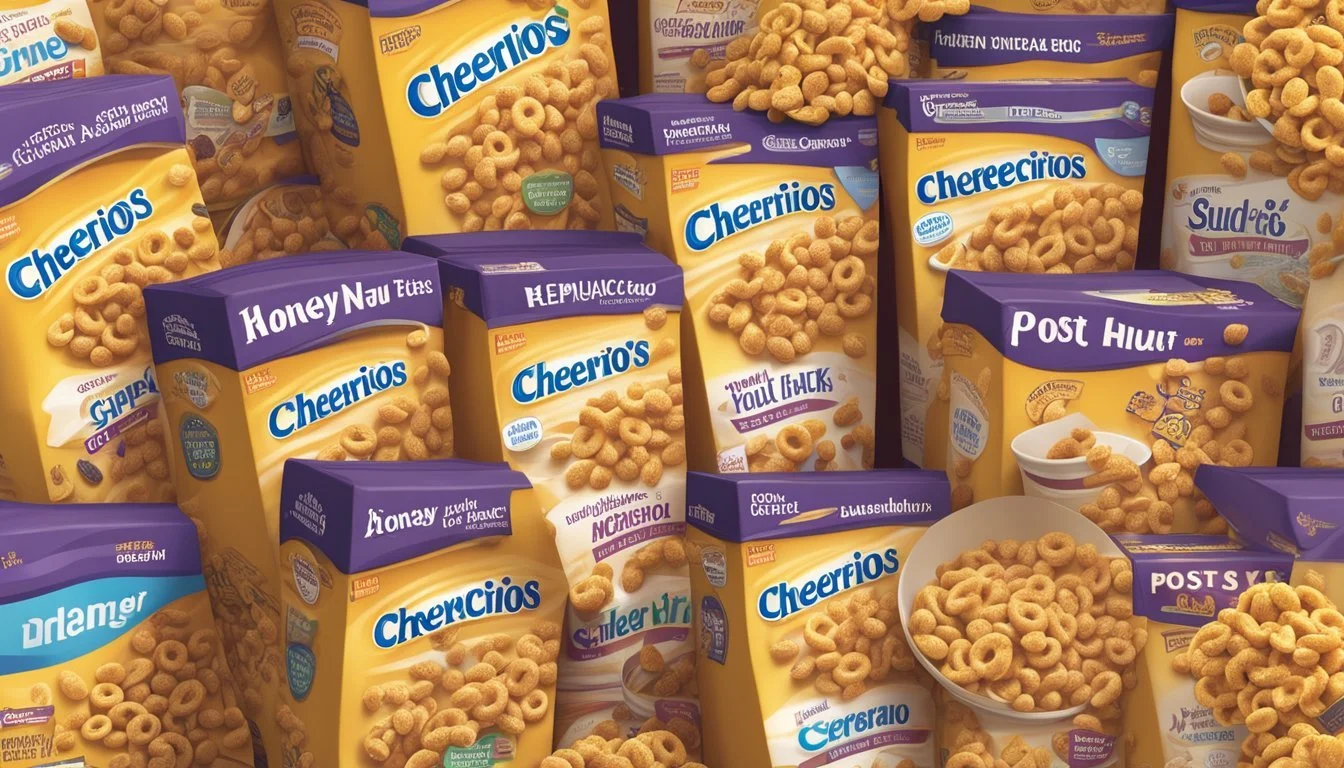Honey Nut Cheerios vs Post Grape-Nuts Flakes
A Nutritional Comparison
This Article is Part of Our Breakfast Cereal Guide with Details on Honey Nut Cheerios Nutrition and Post GrapevsNut Flakes Nutrition
For those navigating the vast array of breakfast cereals, the debate between Honey Nut Cheerios and Post Grape-Nuts Flakes often arises. Both cereals, from renowned brands General Mills and Post respectively, offer distinct nutritional profiles and potential health benefits. Honey Nut Cheerios, known for their sweet, nutty flavor, appeal to those with a preference for a touch of sweetness in their morning routine.
In terms of nutritional content, these cereals cater to different dietary preferences. Honey Nut Cheerios have 10 grams of sugars and 11.5 grams of complex carbohydrates per serving, making them a moderate choice for those mindful of sugar intake. Post Grape-Nuts Flakes, on the other hand, contain 17 grams of complex carbohydrates per serving and significantly less sugar, appealing to those prioritizing lower sugar content in their diet.
Whether one is seeking a sweeter start to the day or a more fiber-rich option, understanding the essential nutritional differences can help in making an informed choice. Honey Nut Cheerios and Grape-Nuts Flakes each bring their unique flavors and health benefits to the breakfast table.
Historical Background
The development of Honey Nut Cheerios and Post Grape-Nuts Flakes reflects the innovation and diversity in the breakfast cereal industry. Each product offers unique characteristics and histories tied to their respective manufacturers, General Mills and Post.
Development of Honey Nut Cheerios
Honey Nut Cheerios, a variety of the original Cheerios, was introduced by General Mills in 1979. The creation of this new variant was spearheaded by Yandel Gonzalez. Initially, actual nuts were included in the formulation until 2006, enhancing the cereal's flavor.
General Mills aimed to provide a sweeter option to their standard Cheerios. They incorporated honey and almond flavoring—a combination that quickly became popular among consumers. Over the years, Honey Nut Cheerios has maintained its status as one of the top-selling cereals in the United States, due in part to its appealing taste profile and broad marketing efforts.
Evolution of Post Grape-Nuts Flakes
Post introduced Grape-Nuts Flakes as a lighter alternative to its original Grape-Nuts cereal. Unlike the solid, crunchy nature of the original, Grape-Nuts Flakes offer a thin, crispy texture, making them a different kind of breakfast experience.
Grape-Nuts itself was created in 1897 by C.W. Post. The brand was built on promoting health benefits and utilizing a nutty flavor derived from wheat and barley. Grape-Nuts Flakes inherited this health-centric image, offering consumers a product rich in complex carbohydrates and fiber.
While not as widely recognized as other types of cereals, Post's Grape-Nuts Flakes provides a nutritious breakfast option that has stood the test of time. The history of these flakes ties closely to Post's long-standing tradition of innovation in breakfast foods.
Nutritional Comparison
When comparing Honey Nut Cheerios and Post Grape-Nuts Flakes, it's essential to examine the calorie content, macronutrients, fiber and whole grain content, sugars, and vitamin and mineral fortification. Each of these factors plays a crucial role in determining which cereal might be a better choice for a healthy breakfast.
Calorie Content Analysis
Honey Nut Cheerios provides approximately 110 calories per 3/4 cup serving. Post Grape-Nuts Flakes offers around 120 calories per 3/4 cup serving.
The difference in calorie content is minimal and may not significantly impact daily intake. Caloric content should be considered alongside other nutritional factors to make an informed choice.
Macronutrients Breakdown
Honey Nut Cheerios contains 2 grams of protein, 2 grams of fat, and 11.5 grams of complex carbohydrates per serving.
Post Grape-Nuts Flakes provides 2 grams of protein, 0.5 grams of fat, and 15 grams of complex carbohydrates per serving. While both cereals contain similar protein levels, Grape-Nuts Flakes are lower in fats. The difference in complex carbohydrates can also influence energy levels and satiety.
Fiber and Whole Grain Content
Dietary fiber is crucial for digestive health. Honey Nut Cheerios contains 2 grams of dietary fiber per serving.
Post Grape-Nuts Flakes offer 3 grams of fiber per serving. Whole grain content is higher in Grape-Nuts Flakes, making it a more fiber-rich option, which can support better digestive health and prolonged satiety.
Sugars and Sweetness Factor
Honey Nut Cheerios contains 9 grams of sugars per serving, including added sugars.
Post Grape-Nuts Flakes have only 4 grams of sugars per serving with less added sugar. Those looking to reduce their sugar intake might prefer Grape-Nuts Flakes due to its lower sugar content. The sweetness of Honey Nut Cheerios, due to added sugars, might appeal more to those with a sweet tooth.
Vitamin and Mineral Fortification
Both cereals are fortified with essential vitamins and minerals. Honey Nut Cheerios includes Vitamin A, Vitamin C, Calcium, and Iron, meeting different FDA daily recommendations for these nutrients.
Post Grape-Nuts Flakes are also fortified, containing significant levels of Vitamin D, Iron, and Folic Acid. Both cereals provide vital nutrients, but the specific vitamin and mineral fortifications may vary, so consumers should select based on their nutritional needs.
Health Considerations
When considering Honey Nut Cheerios and Post Grape-Nuts Flakes, it is important to evaluate their impact on diet, allergens, fiber content, and added sugars. Each of these factors can significantly influence the overall health benefits of these breakfast cereals.
Impact on Diet and Weight
Honey Nut Cheerios contain more calories per serving compared to Grape-Nuts Flakes. Honey Nut Cheerios can offer a sweeter taste, which might be preferred by those with a tendency to consume sugary foods. Consequently, this can impact diet choices, particularly if aiming for a lower sugar intake.
On the other hand, Grape-Nuts Flakes offer a denser nutrient profile in smaller quantities. This can be beneficial for those monitoring their diet more strictly. Both cereals provide protein, but Grape-Nuts generally contain a higher amount, making it a more suitable option for those heavily focusing on their protein intake in a healthy breakfast.
Allergens and Dietary Restrictions
Honey Nut Cheerios include nuts, specifically almonds, and are not suitable for individuals with nut allergies. This cereal also contains gluten, making it inappropriate for those with celiac disease or gluten intolerance.
Grape-Nuts Flakes, produced by Post, are also not gluten-free. However, they do not contain nuts, making them safer for nut-allergic individuals. Neither of these cereals is inherently vegan due to potential processing aids or vitamin additives derived from animal sources, though both could be included in vegetarian diets.
Benefits of Fiber and Whole Grains
Both cereals boast the inclusion of whole grains, which are rich in fiber, essential for digestive health. Honey Nut Cheerios have around 2.7 grams of fiber per serving, significantly contributing to daily fiber intake. Whole grains in this cereal also add B vitamins and minerals like iron and folate.
Grape-Nuts Flakes provide a similar amount of fiber, promoting fullness and steady energy release. High fiber content is beneficial in controlling blood sugar levels and aiding in weight management by providing a feeling of satiety. Whole grains are vital for a balanced diet, contributing to long-term health benefits.
Added Sugars and Their Effects
Honey Nut Cheerios have added sugars to enhance flavor, making them a sweeter choice among breakfast cereals. Excessive added sugar can lead to heightened risks of obesity, diabetes, and other metabolic conditions. It’s a factor to be mindful of, especially for those controlling calorie and sugar intake.
Grape-Nuts Flakes, in comparison, contain lower amounts of added sugars. This makes them a preferable choice for those looking to limit their sugary cereal consumption. Reducing added sugar intake is vital for promoting better health outcomes, especially in maintaining reasonable caloric intake and preventing disease linked to high sugar consumption.
Taste and Texture Profile
Honey Nut Cheerios and Post Grape-Nuts Flakes offer distinct taste and texture experiences. Each cereal brings unique flavors and mouthfeels that cater to different preferences, whether enjoyed with milk or on their own as a breakfast cereal.
Flavor Comparison
Honey Nut Cheerios: These are characterized by their sweet, honey-coated oat taste. The honey flavor is prominent and pairs well with the oat base, creating a balance that appeals to those who enjoy a sweeter cereal.
Post Grape-Nuts Flakes: In contrast, these emphasize a nuttier, earthier flavor profile. The whole grain and toasted notes are more pronounced, delivering a subtler sweetness. This makes them a suitable alternative for those who prefer a less sugary start to their day.
Both cereals can be enhanced by adding fruit, nuts, or even a dollop of yogurt. These additions can complement the base flavors and add extra nutritional value, creating a more rounded and enjoyable breakfast experience.
Crunchiness and Mouthfeel
Honey Nut Cheerios: These cereals have a light, airy texture that provides a satisfying initial crunch. When combined with milk, they retain their crispness for a short period before becoming slightly softer, still maintaining a pleasant experience.
Post Grape-Nuts Flakes: These offer a heartier crunch that lasts longer in milk. Their denser structure means they stay crispier for longer, making them a great choice for those who prefer a firmer cereal throughout their meal.
The textural contrast between the two cereals is evident. Honey Nut Cheerios provide a lighter, more delicate crunch, whereas Post Grape-Nuts Flakes deliver a robust, lasting crispness. These distinctive mouthfeels cater to different preferences, ensuring a satisfying experience for a variety of consumers.
Brand Reputation and Variety
Honey Nut Cheerios and Post Grape-Nuts Flakes are both popular cereals with strong brand recognition. Each brand offers a wide variety of products catering to different tastes and preferences.
General Mills' Brand Portfolio
General Mills, the manufacturer of Honey Nut Cheerios, has a well-established reputation in the cereal market.
Besides Honey Nut Cheerios, their portfolio includes iconic brands like Wheaties and Lucky Charms.
These brands have consistently performed well in sales, contributing to the company's General Mills Total revenue.
Consumer reports often highlight the brand's focus on quality and nutrition, ensuring that their cereals remain a staple in many households.
Wheaties, known as the "Breakfast of Champions," has been a favorite for athletes and fitness enthusiasts. Lucky Charms, beloved for its marshmallow shapes, frequently ranks high in popularity among children and adults alike.
Post's Range of Cereal Products
Post Consumer Brands, the maker of Grape-Nuts Flakes, also boasts a diverse range of cereals.
The Post Grape-Nuts Original is a classic favorite known for its crunch and high nutritional content.
Other notable cereals include Raisin Bran Crunch, which combines bran flakes with raisins, and Fruity Pebbles, celebrated for its vibrant colors and fruity taste.
Post consistently focuses on offering products that appeal to a broad audience, from those seeking health-conscious choices to families looking for fun and flavorful options.
The brand's commitment to variety ensures there is something for everyone, maintaining its strong position in the market.
Environmental and Ethical Considerations
Both Honey Nut Cheerios and Post Grape-Nuts Flakes take steps towards environmental and ethical sustainability. These can be seen through their sourcing of ingredients and sustainability practices.
Sourcing of Ingredients
Honey Nut Cheerios, produced by General Mills, emphasizes the use of whole grain oats and real honey. They partner with farmers to ensure that the oats are sourced using sustainable farming practices. This reduces the environmental impact and supports the agricultural community.
Post Grape-Nuts Flakes, on the other hand, focuses on providing nutritious whole grains. Post works with suppliers to ensure these grains are grown sustainably. They prioritize organic practices where feasible, which helps to minimize the use of harmful pesticides and supports soil health.
Sustainability Practices of Companies
General Mills has made significant strides in sustainability by setting aside acreage for bee habitats. Specifically, Honey Nut Cheerios has facilitated the creation of 3,300 acres of pollinator habitats. This initiative supports biodiversity and helps maintain the health of bee populations, which are crucial for pollination.
Post actively promotes sustainable farming through its supply chain. They encourage practices that support soil health and reduce carbon footprints. By investing in sustainable agriculture, both companies aim to reduce their environmental impact, ensuring long-term viability for future generations.
Their transparency and commitment to these practices reflect their dedication to both environmental stewardship and ethical sourcing.
Consumption Trends and Consumer Preferences
Shifts in consumer behavior and health consciousness have influenced the popularity and consumption patterns of Honey Nut Cheerios and Post Grape-Nuts Flakes. Understanding these trends provides insights into what drives consumer choices in the cereal aisle.
Market Trends in Cereal Consumption
Breakfast cereals remain a staple in many households. Supermarkets stock a wide variety, reflecting the sustained popularity of these products. Honey Nut Cheerios, known for their sweet flavor, appeal to a broad demographic, driving consistent sales.
Conversely, Grape-Nuts Flakes cater to a niche market prioritizing health benefits. Ranking higher in cereal ratings by nutrition experts, they attract consumers interested in higher protein and fiber content. This has contributed to a steady consumer base despite a less sweet profile compared to Honey Nut Cheerios.
Shifts Towards Healthier Options
There has been a clear shift towards healthier breakfast options. Consumers are increasingly looking for cereals with lower sugar and higher protein content. Honey Nut Cheerios, while popular for taste, have faced scrutiny from those seeking to reduce sugar intake.
Grape-Nuts Flakes have seen a rise in preference among health-conscious consumers. Emphasizing their nutritional benefits, such as complex carbohydrates and dietary fiber, these cereals align with the growing trend of healthier eating habits. This shift is reflected in supermarket sales data showing gradual increases in purchases of nutritious breakfast options.
Packaging and Pricing
When choosing between Honey Nut Cheerios and Post Grape-Nuts Flakes, consumers often consider both packaging design and pricing to determine value and shelf appeal. These elements can influence purchase decisions significantly.
Box Design and Shelf Appeal
Honey Nut Cheerios boxes feature vibrant yellow tones with playful bee mascots, appealing to children and families. The bold, attractive design enhances visibility on supermarket shelves.
Post Grape-Nuts Flakes packages employ a more subdued color palette with images of wholesome grains, targeting health-conscious buyers. Both brands offer various sizes, including economy sizes and family packs, catering to different purchasing needs.
Effective advertising elements on the boxes, such as call-outs for nutritional benefits, entice consumers. Cheerios often highlight heart health benefits, whereas Grape-Nuts Flakes emphasize fiber content.
Comparative Cost Analysis
Price per serving is crucial for shoppers seeking value. Honey Nut Cheerios generally offer an inexpensive price per ounce, making it attractive for budget-conscious families. Supermarket prices may vary, but Cheerios commonly retail at competitive rates.
Grape-Nuts Flakes, while slightly higher in cost, provide a more nutrient-dense option, justifying the extra expense for some consumers. In comparative cost analysis, the serving weight (ounces per serving) also plays a role. Typically, Honey Nut Cheerios are available in larger family packs offering reduced cost per ounce, whereas Grape-Nuts Flakes often come in economy sizes focused on long-term storage and serving size efficiency.
Consumer Reports frequently cite both cereals for their value but highlight differences in cost vs. nutritional payoff.
More on Honey Nut Cheerios
Cinnamon Toast Crunch vs Honey Nut Cheerios: Which is better?
Honey Nut Cheerios vs Kellogg's Apple Jacks: Which is better?
Honey Nut Cheerios vs Kellogg's Froot Loops: Which is better?
Honey Nut Cheerios vs Post Raisin Bran Cereal: Which is better?
More on Post Grape-Nuts Flakes
Cinnamon Toast Crunch vs Post GrapevsNut Flakes: Which is better?
French Toast Crunch vs Post GrapevsNut Flakes: Which is better?
Kellogg's Apple Jacks vs Post GrapevsNut Flakes: Which is better?
Kellogg's Froot Loops vs Post GrapevsNut Flakes: Which is better?
Post GrapevsNut Flakes vs Post Raisin Bran Cereal: Which is better?






